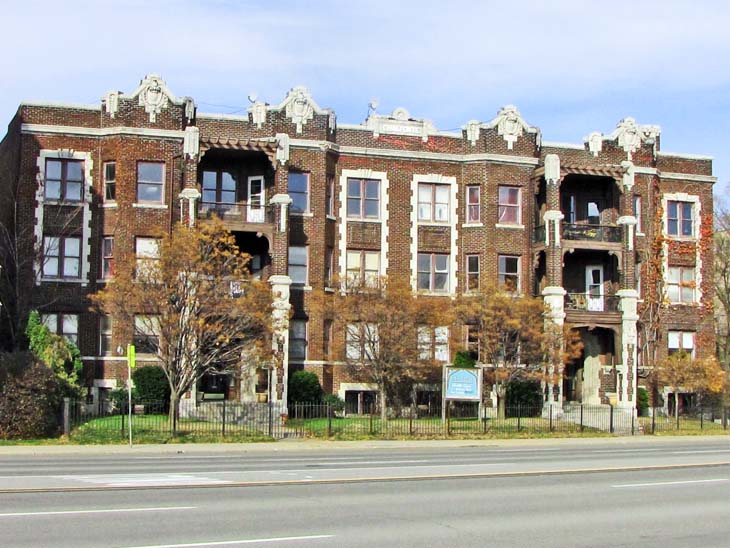

Compared to the large eastern seaboard cities that grew rapidly
in the same era, there are few apartment districts in Detroit. Land for the
construction of single-family homes was widely available in the Motor City
in the 1920s. There are a couple of apartment house districts in Detroit. A
variety
of architecturally
interesting structures were built in Palmer
Park Apartment House District between
the 1920s and the first few years after World War II. Prior to the Depression decade, quite a few
impressive apartment buildings—some high rise and some low rise—were
built along East Jefferson. This area had the appeal of being close to the Detroit
River, although the riverfront was much less attractive at that time than now
because of the factories and rail lines formerly located there. This area also
had the appeal of being connected to downtown employment centers through the
Jefferson Avenue trolley.
The City of Detroit’s Planning and Development Department designated the
buildings you see as a local historic district and they are listed on the National
Register of Historic Places. Nevertheless, I know little about their historical
significance. Investors William and John Hart built two linked and identical
buildings on East Jefferson, and then constructed an annex in a somewhat similar
style around the corner at 915 Fischer. They were completed in 1911. Fifteen
years later, Writ Rowland designed the impressive Jefferson
Avenue Presbyterian
Church next door. I do not know what occupied the land where this Gothic church
now stands. The ascetic appeal of these East Jefferson apartments flows from
the architect’s use of dark red brick and the elaborate cast stone trim.
Note the many embellishments on the front of these buildings. The extensive and
rather complex decorations at the roofline and the structure’s name in
stone draw your attention to the top of this short building. I believe that Jefferson
Avenue Presbyterian purchased these apartments in 1969 but I do not know if they
are still held by that church.
As employment grows in downtown Detroit, real estate investors increasingly see a market for attractive units near the city's center. The apartment area just northeast of the MacArthur Bridge to Belle Isle has been labeled "Detroit's Gold Coast" after investments were made to refurbish the dozen or so building located there. This may suggest a bright future for the Chalfonte Apartment and a few other apartment building along East Jefferson.
The architect, Henry O'Dell, was born near present day Port Huron in 1875 and moved to Detroit at age 20. He obtained a job as a draftsman and worked for some of the city's leading architects of that era: William Higgenbotham, MacFarlane, William Malcomson, George Mason and Randolph Rogers. O'Dell joined with Frank Baxter to open their own firm in 1902. O'Dell had a long a productive career in Detroit including helping to design the Ford Auditorium at Hart Plaza, a building razed in 2010. The home Henry O'Dell designed for himself in Bloomfield Hills is listed on the National Register of Historic Places
Architect: Frank G. Baxter and Henry Augustus O'Dell
Date of Completion: 1911
Architectural Style
Use in 2014: Apartment Building
City of Detroit Local Historic District: Listed March 3, 1985
State of Michigan Register of Historic Sites: Not listed
National Register of Historic Places: #85003603; Listed in 1985.
Picture: Ren Farley
Description updated: April, 2014